在Qt5编程教程的这一部分,我们将谈论小部件的布局管理。我们提到QHBoxLayout、QVBoxLayout、QFormLayout和QGridLayout管理器。
一个典型的应用程序由各种小部件组成。这些widget被放置在布局中。一个程序员必须管理应用程序的布局。在Qt5中,我们有两个选择:
绝对定位
布局管理器
绝对定位
在绝对定位中,程序员会指定每个小部件的像素位置和大小。当我们使用绝对定位时,我们必须了解以下几点:
如果我们调整窗口大小,小部件的大小和位置不会改变。
应用程序在不同平台上的外观不同(通常较差)。
更改应用程序中的字体可能会破坏布局。
如果我们决定更改布局,则必须完全重新设计布局,这是繁琐和耗时的。
在某些情况下可能可以使用绝对定位,但在实际的程序中,程序员会使用布局管理器。
absolute.cpp
#include <QApplication>
#include <QDesktopWidget>
#include <QTextEdit>
class Absolute : public QWidget {
public:
Absolute(QWidget *parent = nullptr);
};
Absolute::Absolute(QWidget *parent)
: QWidget(parent) {
auto *ledit = new QTextEdit(this);
ledit->setGeometry(5, 5, 200, 150);
}
int main(int argc, char *argv[]) {
QApplication app(argc, argv);
Absolute window;
window.setWindowTitle("Absolute");
window.show();
return app.exec();
}setGeometry方法用于以绝对坐标在窗口上定位小部件。
auto *edit = new QTextEdit(this);
ledit->setGeometry(5, 5, 200, 150);
我们创建了一个QTextEdit小部件,并手动定位它。setGeometry方法有两个作用:它将小部件定位到绝对坐标,并调整小部件的大小。
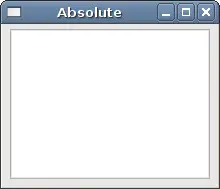
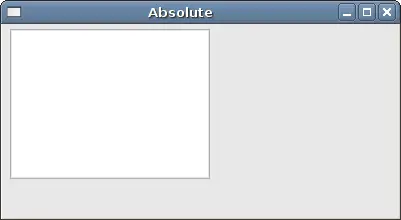
Qt5 QVBoxLayout
QVBoxLayout 类可以将小部件垂直排列。小部件可以使用 addWidget 方法添加到布局中。
vertical_box.h
#pragma once
#include <QWidget>
class VerticalBox : public QWidget {
public:
VerticalBox(QWidget *parent = nullptr);
};
The header file.
vertical_box.cpp
#include <QVBoxLayout>
#include <QPushButton>
#include "vertical_box.h"
VerticalBox::VerticalBox(QWidget *parent)
: QWidget(parent) {
auto *vbox = new QVBoxLayout(this);
vbox->setSpacing(1);
auto *settings = new QPushButton("Settings", this);
settings->setSizePolicy(QSizePolicy::Expanding, QSizePolicy::Expanding);
auto *accounts = new QPushButton("Accounts", this);
accounts->setSizePolicy(QSizePolicy::Expanding, QSizePolicy::Expanding);
auto *loans = new QPushButton("Loans", this);
loans->setSizePolicy(QSizePolicy::Expanding, QSizePolicy::Expanding);
auto *cash = new QPushButton("Cash", this);
cash->setSizePolicy(QSizePolicy::Expanding, QSizePolicy::Expanding);
auto *debts = new QPushButton("Debts", this);
debts->setSizePolicy(QSizePolicy::Expanding, QSizePolicy::Expanding);
vbox->addWidget(settings);
vbox->addWidget(accounts);
vbox->addWidget(loans);
vbox->addWidget(cash);
vbox->addWidget(debts);
setLayout(vbox);
}在我们的示例中,我们有一个垂直布局管理器。我们将五个按钮放入其中。我们使所有按钮在两个方向上可扩展。
auto *vbox = new QVBoxLayout(this);vbox->setSpacing(1);
我们创建 QVBoxLayout 并在子小部件之间设置 1 像素的间距。
auto *settings = new QPushButton("Settings", this);
settings->setSizePolicy(QSizePolicy::Expanding, QSizePolicy::Expanding);
我们创建一个按钮并设置其大小策略。子小部件由布局管理器管理。默认情况下,按钮在水平方向上扩展,垂直方向上具有固定大小。如果我们想要更改它,我们设置新的大小策略。在我们的情况下,按钮可以在两个方向上扩展。
vbox->addWidget(settings);
vbox->addWidget(accounts);
...
我们使用 addWidget 方法将子小部件添加到布局管理器中。
setLayout(vbox);
我们为窗口设置 QVBoxLayout 管理器。
main.cpp
#include <QApplication>
#include "vertical_box.h"
int main(int argc, char *argv[]) {
QApplication app(argc, argv);
VerticalBox window;
window.resize(240, 230);
window.setWindowTitle("VerticalBox");
window.show();
return app.exec();
}主文件。
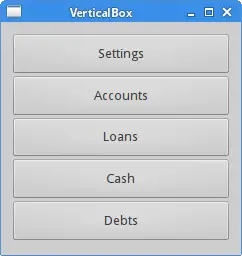
按钮
在下面的例子中,我们在窗口的客户区域显示了两个按钮。它们将位于窗口的右下角。
buttons.h
#pragma once
#include <QWidget>
#include <QPushButton>
class Buttons : public QWidget {
public:
Buttons(QWidget *parent = nullptr);
private:
QPushButton *okBtn;
QPushButton *applyBtn;
};
Header file.
buttons.cpp
#include <QVBoxLayout>
#include <QHBoxLayout>
#include "buttons.h"
Buttons::Buttons(QWidget *parent)
: QWidget(parent) {
auto *vbox = new QVBoxLayout(this);
auto *hbox = new QHBoxLayout();
okBtn = new QPushButton("OK", this);
applyBtn = new QPushButton("Apply", this);
hbox->addWidget(okBtn, 1, Qt::AlignRight);
hbox->addWidget(applyBtn, 0);
vbox->addStretch(1);
vbox->addLayout(hbox);
}假设我们想在窗口的右下角有两个按钮。
auto *vbox = new QVBoxLayout(this);
auto *hbox = new QHBoxLayout();
我们创建了两个盒式布局管理器:一个是垂直的,一个是水平的。
okBtn = new QPushButton("OK", this);
applyBtn = new QPushButton("Apply", this);
我们创建了两个按钮。
hbox->addWidget(okBtn, 1, Qt::AlignRight);
hbox->addWidget(applyBtn, 0);
将按钮放置在水平布局管理器中。使用addWidget方法。这些按钮是右对齐的。第一个参数是子小部件。第二个参数是拉伸因子,最后一个参数是对齐方式。通过将拉伸因子设置为1,我们为OK按钮提供了从窗口左侧到右侧的空间。小部件不会扩展到分配给它的所有空间。最后,Qt :: AlignRight常量将小部件对齐到分配的空间的右侧。
vbox->addStretch(1);
vbox->addLayout(hbox);
我们通过调用addStretch方法在垂直盒中放置一个空的可扩展空间。然后将水平盒布局添加到垂直盒布局中。
main.cpp
#include <QApplication>
#include "buttons.h"
int main(int argc, char *argv[]) {
QApplication app(argc, argv);
Buttons window;
window.resize(290, 170);
window.setWindowTitle("Buttons");
window.show();
return app.exec();
}主文件。
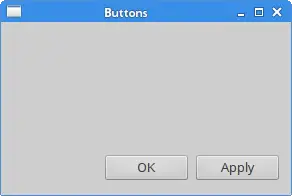
Qt5 嵌套布局
以下示例的想法是展示布局管理器可以组合使用。通过组合甚至是简单的布局,我们可以创建复杂的对话框或窗口。为了嵌套布局,我们使用 addLayout 方法。
nesting.h
#pragma once
#include <QWidget>
class Layouts : public QWidget {
public:
Layouts(QWidget *parent = nullptr);
};
This is the header file.
nesting.cpp
#include <QVBoxLayout>
#include <QPushButton>
#include <QListWidget>
#include "nesting.h"
Layouts::Layouts(QWidget *parent)
: QWidget(parent) {
auto *vbox = new QVBoxLayout();
auto *hbox = new QHBoxLayout(this);
auto *lw = new QListWidget(this);
lw->addItem("The Omen");
lw->addItem("The Exorcist");
lw->addItem("Notes on a scandal");
lw->addItem("Fargo");
lw->addItem("Capote");
auto *add = new QPushButton("Add", this);
auto *rename = new QPushButton("Rename", this);
auto *remove = new QPushButton("Remove", this);
auto *removeall = new QPushButton("Remove All", this);
vbox->setSpacing(3);
vbox->addStretch(1);
vbox->addWidget(add);
vbox->addWidget(rename);
vbox->addWidget(remove);
vbox->addWidget(removeall);
vbox->addStretch(1);
hbox->addWidget(lw);
hbox->addSpacing(15);
hbox->addLayout(vbox);
setLayout(hbox);
}在示例中,我们创建了一个窗口,其中包含四个按钮和一个列表小部件。按钮分组成垂直列,并放置在列表小部件的右侧。如果我们调整窗口大小,列表小部件也会被调整大小。
auto *vbox = new QVBoxLayout();
QVBoxLayout 是按钮的列。
auto *hbox = new QHBoxLayout(this);
QHBoxLayout 是小部件的基本布局。
auto *lw = new QListWidget(this);
lw->addItem("The Omen");
lw->addItem("The Exorcist");
lw->addItem("Notes on a scandal");
lw->addItem("Fargo");
lw->addItem("Capote");
创建 QListWidget。
auto *add = new QPushButton("Add", this);
auto *rename = new QPushButton("Rename", this);
auto *remove = new QPushButton("Remove", this);
auto *removeall = new QPushButton("Remove All", this);
在这里创建了四个按钮。
vbox->setSpacing(3);
vbox->addStretch(1);
vbox->addWidget(add);
vbox->addWidget(rename);
vbox->addWidget(remove);
vbox->addWidget(removeall);
vbox->addStretch(1);
创建了带有四个按钮的垂直框。我们在按钮之间加了一些小间距。请注意,我们在垂直框的顶部和底部添加了一个伸展因子。这样按钮就可以垂直居中。
hbox->addWidget(lw);
hbox->addSpacing(15);
hbox->addLayout(vbox);
将列表小部件和按钮的垂直框放置在水平框布局中。addLayout 方法用于将布局添加到另一个布局中。
setLayout(hbox);
设置父窗口的基本布局。
main.cpp
#include <QApplication>
#include "nesting.h"
int main(int argc, char *argv[]) {
QApplication app(argc, argv);
Layouts window;
window.setWindowTitle("Layouts");
window.show();
return app.exec();
}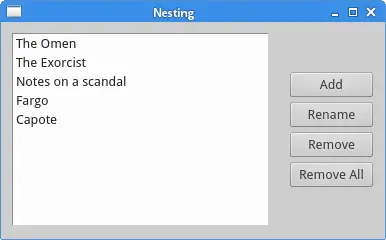
Qt5 FormLayout
QFormLayout是一个简单的布局管理器,用于管理输入控件及其关联标签的表单。它将其子控件布置在一个两列的表单中。左列包含标签,右列包含诸如QLineEdit或QSpinBox之类的输入控件。
form.h
#pragma once
#include <QWidget>
class FormEx : public QWidget {
public:
FormEx(QWidget *parent = nullptr);
};
form.cpp
#include <QFormLayout>
#include <QLabel>
#include <QLineEdit>
#include "form.h"
FormEx::FormEx(QWidget *parent)
: QWidget(parent) {
auto *nameEdit = new QLineEdit(this);
auto *addrEdit = new QLineEdit(this);
auto *occpEdit = new QLineEdit(this);
auto *formLayout = new QFormLayout;
formLayout->setLabelAlignment(Qt::AlignRight | Qt::AlignVCenter);
formLayout->addRow("Name:", nameEdit);
formLayout->addRow("Email:", addrEdit);
formLayout->addRow("Age:", occpEdit);
setLayout(formLayout);
}该示例创建了一个由三个标签和三个LineEdit组成的表单。
auto *formLayout = new QFormLayout;
创建了一个QFormLayout的实例。
formLayout->setLabelAlignment(Qt::AlignRight | Qt::AlignVCenter);
通过setLabelAlignment方法设置标签控件的对齐方式。
formLayout->addRow("Name:", nameEdit);
addRow方法在表单布局底部添加一行,包含给定的标签和输入控件。
main.cpp
#include <QApplication>
#include "form.h"
int main(int argc, char *argv[]) {
QApplication app(argc, argv);
FormEx window;
window.setWindowTitle("Form example");
window.show();
return app.exec();
}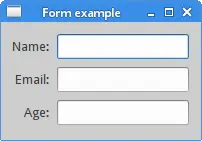
Qt5 QGridLayout
QGridLayout(网格布局)将窗口部件放置在网格中。它是一个强大的布局管理器。
calculator.h
#pragma once
#include <QWidget>
class Calculator : public QWidget {
public:
Calculator(QWidget *parent = nullptr);
};
Header file.
calculator.cpp
#include <QGridLayout>
#include <QPushButton>
#include "calculator.h"
Calculator::Calculator(QWidget *parent)
: QWidget(parent) {
auto *grid = new QGridLayout(this);
grid->setSpacing(2);
QVector<QString> values({ "7", "8", "9", "/",
"4", "5", "6", "*",
"1", "2", "3", "-",
"0", ".", "=", "+"
});
int pos = 0;
for (int i=0; i<4; i++) {
for (int j=0; j<4; j++) {
auto *btn = new QPushButton(values[pos], this);
btn->setFixedSize(40, 40);
grid->addWidget(btn, i, j);
pos++;
}
}
setLayout(grid);
}我们创建了一个计算器的框架。
auto *grid = new QGridLayout(this);
grid->setSpacing(2);
我们创建了网格布局,并在子窗口部件之间设置了2像素的间距。
QVector<QString> values({ "7", "8", "9", "/","4", "5", "6", "*","1", "2", "3", "-","0", ".", "=", "+"});
这些是在按钮上显示的字符。
for (int i=0; i<4; i++) {
for (int j=0; j<4; j++) {
auto *btn = new QPushButton(values[pos], this);
btn->setFixedSize(40, 40);
grid->addWidget(btn, i, j);
pos++;
}
}我们将16个窗口部件放入网格布局中。每个按钮都有一个固定的大小。
main.cpp
#include <QApplication>
#include "calculator.h"
int main(int argc, char *argv[]) {
QApplication app(argc, argv);
Calculator window;
window.setWindowTitle("Calculator");
window.show();
return app.exec();
}这是主文件

下面代码创建了一个使用 QGridLayout 管理器的复杂窗口。
review.h
#pragma once
#include <QWidget>
class Review : public QWidget {
public:
Review(QWidget *parent = nullptr);
};
Header file.
review.cpp
#include <QGridLayout>
#include <QLabel>
#include <QLineEdit>
#include <QTextEdit>
#include "review.h"
Review::Review(QWidget *parent)
: QWidget(parent) {
auto *grid = new QGridLayout(this);
grid->setVerticalSpacing(15);
grid->setHorizontalSpacing(10);
auto *title = new QLabel("Title:", this);
grid->addWidget(title, 0, 0, 1, 1);
title->setAlignment(Qt::AlignRight | Qt::AlignVCenter);
auto *edt1 = new QLineEdit(this);
grid->addWidget(edt1, 0, 1, 1, 1);
auto *author = new QLabel("Author:", this);
grid->addWidget(author, 1, 0, 1, 1);
author->setAlignment(Qt::AlignRight | Qt::AlignVCenter);
auto *edt2 = new QLineEdit(this);
grid->addWidget(edt2, 1, 1, 1, 1);
auto *review = new QLabel("Review:", this);
grid->addWidget(review, 2, 0, 1, 1);
review->setAlignment(Qt::AlignRight | Qt::AlignTop);
auto *te = new QTextEdit(this);
grid->addWidget(te, 2, 1, 3, 1);
setLayout(grid);
}这段代码创建了一个窗口,可以用于输入一本书的作者、标题和评论。
auto *grid = new QGridLayout(this);
创建了 QGridLayout 管理器。
grid->setVerticalSpacing(15);
grid->setHorizontalSpacing(10);
使用 setVerticalSpacing 方法和 setHorizontalSpacing 方法添加了垂直和水平间距。
auto *title = new QLabel("Title", this);
grid->addWidget(title, 0, 0, 1, 1);
这些代码行创建了一个标签小部件,并将其放置在网格布局中。addWidget 方法有五个参数。第一个参数是子部件,本例中是一个标签。接下来的两个参数是我们放置标签的行和列。最后,最后的参数是 rowspan 和 colspan。这些参数指定当前小部件将跨越多少行。在本例中,标签将跨越一个列和一行。
title->setAlignment(Qt::AlignRight | Qt::AlignVCenter);
setAlignment 方法将标题标签对齐到其单元格中。水平方向上,右对齐。垂直方向上,居中对齐。
auto *te = new QTextEdit(this);
grid->addWidget(te, 2, 1, 3, 1);
QTextEdit 小部件放置在第三行和第二列;它跨越三行和一列。
main.cpp
#include <QApplication>
#include "review.h"
int main(int argc, char *argv[]) {
QApplication app(argc, argv);
Review window;
window.setWindowTitle("Review");
window.show();
return app.exec();
}





 本文介绍了Qt5中用于管理小部件布局的几种方法,包括绝对定位和使用布局管理器如QHBoxLayout,QVBoxLayout,QFormLayout和QGridLayout。绝对定位虽然简单但不灵活,而布局管理器能自动适应窗口大小变化和不同平台。示例代码展示了如何使用这些布局管理器创建各种界面布局。
本文介绍了Qt5中用于管理小部件布局的几种方法,包括绝对定位和使用布局管理器如QHBoxLayout,QVBoxLayout,QFormLayout和QGridLayout。绝对定位虽然简单但不灵活,而布局管理器能自动适应窗口大小变化和不同平台。示例代码展示了如何使用这些布局管理器创建各种界面布局。
















 2881
2881

 被折叠的 条评论
为什么被折叠?
被折叠的 条评论
为什么被折叠?








